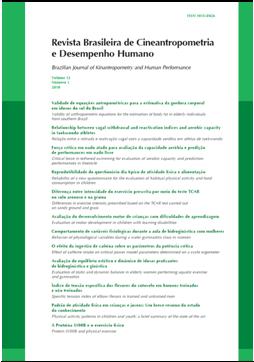Relationship between vagal withdrawaland reactivation indices and aerobic capacity in taekwondo athletes
DOI:
https://doi.org/10.1590/1980-0037.2010v12n1p8Resumen
The aim of this study was to evaluate the relationship between vagal withdrawal and reactivation indices and maximal running velocity (Vmax) in taekwondo athletes. Eleven elite taekwondo athletes (seven men: 23.7±2.2 years, 72.4±7.0 kg, 178.8±7.5 cm, 51.9±2.9 ml.kg-1.min-1, and four women: 18.8±1.5 years, 61.8±1.8 kg, 168.0±4.4 cm, 41.6±2.4 ml.kg-1.min-1) performed a graded exercise test until exhaustion, with the last complete stage performed corresponding to Vmax. Heart rate variability (HRV) parameters were calculated at 1-minute intervals until 85% of maximum HR and plotted against time for the estimation of vagal withdrawal indices (?, amplitude (A) and area under the curve (AUC)). Vagal reactivation indices were determined based on HR recovery during the first 60 s (HRR60s) and negative reciprocal of the slope of the regression line obtained during the first 30 s of HRR (T30). The vagal withdrawal parameters A and AUC were moderately and significantly correlated with Vmax (r = 0.61-0.71, P < 0.05), whereas ? presented a low correlation (r = 0.22-0.40, P > 0.05). T30 and HRR60s were also significantly correlated with Vmax (r = -0.77 and 0.64, P < 0.05, respectively). The present results showed that vagal withdrawal (A and AUC) and vagal reactivation (T30 and HRR60s) indices were significantly correlated with Vmax, suggesting that these indices can be used for the evaluation and monitoring of aerobic fitness in taekwondo athletes.
Publicado
Número
Sección
Licencia

Direitos Autorais para artigos publicados nesta revista são do autor, com direitos de primeira publicação para a revista. Em virtude da aparecerem nesta revista de acesso público, os artigos são de uso gratuito, com atribuições próprias, em aplicações educacionais e não-comerciais, desde que seja dada a atribuição. Esta obra foi licenciada com uma Licença Creative Commons Atribuição 4.0 Internacional - CC BY


